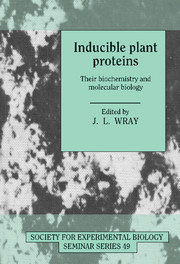Book contents
- Frontmatter
- Contents
- List of Contributors
- Preface
- Metal-binding proteins and metal-regulated gene expression in higher plants
- Phosphate starvation inducible enzymes and proteins in higher plants
- Nitrate reduction in higher plants: molecular approaches to function and regulation
- Inducibility of the glutamine synthetase gene family in Phaseolus vulgaris L.
- Expression and manipulation of genes involved in phenylpropanoid biosynthesis
- Biochemistry and molecular biology of CAM
- ABA- and GA-responsive gene expression
- Regulation of gene expression, ethylene synthesis and ripening in transgenic tomatoes
- Induction of nodulin genes and root nodule symbiosis
- Systemic acquired resistance: an inducible defence mechanism in plants
- Biochemistry and molecular biology of the anaerobic response
- The heat shock response in transgenic plants: the use of chimaeric heat shock genes
- Biochemistry and molecular biology of cold-inducible enzymes and proteins in higher plants
- GBF-1, GBF-2 and GBF-3: three Arabidopsis b-Zip proteins that interact with the light-regulated rbcS-1A promoter
- Index
Systemic acquired resistance: an inducible defence mechanism in plants
Published online by Cambridge University Press: 06 July 2010
- Frontmatter
- Contents
- List of Contributors
- Preface
- Metal-binding proteins and metal-regulated gene expression in higher plants
- Phosphate starvation inducible enzymes and proteins in higher plants
- Nitrate reduction in higher plants: molecular approaches to function and regulation
- Inducibility of the glutamine synthetase gene family in Phaseolus vulgaris L.
- Expression and manipulation of genes involved in phenylpropanoid biosynthesis
- Biochemistry and molecular biology of CAM
- ABA- and GA-responsive gene expression
- Regulation of gene expression, ethylene synthesis and ripening in transgenic tomatoes
- Induction of nodulin genes and root nodule symbiosis
- Systemic acquired resistance: an inducible defence mechanism in plants
- Biochemistry and molecular biology of the anaerobic response
- The heat shock response in transgenic plants: the use of chimaeric heat shock genes
- Biochemistry and molecular biology of cold-inducible enzymes and proteins in higher plants
- GBF-1, GBF-2 and GBF-3: three Arabidopsis b-Zip proteins that interact with the light-regulated rbcS-1A promoter
- Index
Summary
Introduction
Acquired resistance in plants has long been recognised to play an important role in the preservation of plants against disease (Chester, 1933). While much of this early work focused on viral cross-protection, the plants' ability to induce a defence against disease became a topic of research by the early 1960s (Ross, 1961a,b). In these studies tobacco mosaic virus (TMV) was inoculated onto the leaf of a tobacco variety that produced necrotic lesions. Seven days after infection, at a time when lesions had formed on the leaf, both the inoculated leaf and uninfected leaves on the same plant had become resistant to further infection by TMV. The resistance was directed not only against TMV but also other unrelated viruses, as well as certain fungal and bacterial pathogens. Further, the resistance could be induced by other pathogens including viruses, bacteria and fungi, the only common requirement being the development of some necrosis from the infection. Ross referred to the resistance in infected leaves as localised acquired resistance (LAR: Ross, 1961a) and the resistance that developed in the uninfected leaves as systemic acquired resistance (SAR: Ross, 1961b). Although resistance to virus was the main topic of these studies, later emphasis has been on the non-specificity and broad spectrum of SAR against various fungal and bacterial diseases (Hecht & Bateman, 1964; Kuc, 1982; Dean & Kuc, 1985).
A number of exogenously applied chemicals, including polyacrylic acid, acetylsalicylic acid, salicylic acid and isonicotinic acid (NA) derivatives, have also been shown to induce resistance.
- Type
- Chapter
- Information
- Inducible Plant ProteinsTheir Biochemistry and Molecular Biology, pp. 205 - 230Publisher: Cambridge University PressPrint publication year: 1992
- 22
- Cited by



